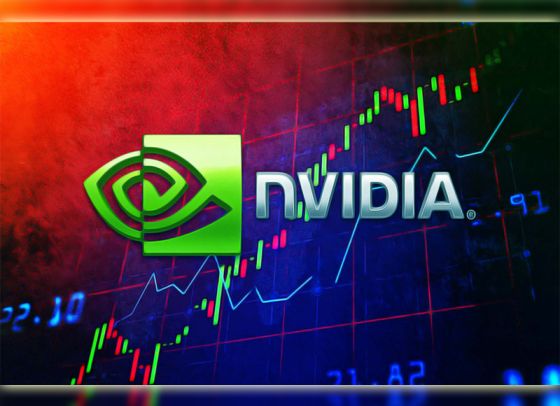Explore the intricate world of Nvidia’s valuation landscape in our article, ‘Decoding Nvidia’s Valuation Puzzle.’ Delve into the company’s strong results, AI prominence, and the considerations investors need to navigate for a clearer perspective on this tech giant’s future.

Nvidia (NASDAQ: NVDA) recently made waves in the market with its robust quarterly results, propelling its shares to new all-time highs. However, the subsequent reversal of gains raises questions about the stock’s valuation. Despite being a frontrunner in artificial intelligence (AI), potential investors should consider several valuation factors. This article delves into Nvidia’s price-to-earnings (P/E) ratio, its earnings growth, and comparative analysis with industry peers.
READ THIS:
- Guiding Through Stock Market Crashes: Insights from Barclays Shares and Strategies for Thriving
- Unraveling the Enigma: Understanding the Recent Volatility in BP’s Share Price
Comparing Price-to-Earnings (P/E) Ratio:
The P/E ratio, a cornerstone valuation metric, juxtaposes a company’s share price with its earnings. While a P/E of 10 is often a yardstick for UK stocks, the tech sector typically commands higher ratios due to future growth prospects. With this, let’s examine the Nasdaq 100 average P/E of 30.17. Contrastingly, Nvidia’s P/E ratio stands at a striking 109, warranting attention. Notably, while earnings have grown by 22% per diluted share in the last quarter, the rapid stock price escalation maintains an elevated P/E ratio, raising concerns about its sustainability.
Decoding Nvidia’s Valuation Puzzle: Earnings Growth and Future Outlook
Though Nvidia’s earnings are on an upward trajectory, the pace might not be sufficient to normalize the heightened P/E ratio. While proponents argue that projected earnings growth justifies the ratio, skeptics remain unconvinced about the continuation of such rapid expansion. As a driving force in AI, Nvidia’s growth potential is promising. However, the question remains whether the trajectory aligns with the current valuation.

Peer Comparison: Nvidia vs. Competitors:
In the semiconductor realm, Nvidia faces competition from Advanced Micro Devices (AMD) and Intel. Nvidia’s stock soared to all-time highs, boasting a remarkable 163% gain this year. Conversely, AMD has seen a modest 5% uptick, while Intel faced a 7% decline in the same period. Despite Nvidia’s AI prowess, both AMD and Intel stand to profit from the sector’s growth. Interestingly, these alternatives offer potentially more reasonable valuations, raising the question of alternative investment avenues.
Balancing Realism and Optimism:
It is paramount to acknowledge the appreciation for Nvidia’s achievements without dismissing its valuation concerns. The company’s rapid growth and substantial profits underscore its prowess. While projections suggest a brighter future for Nvidia, potential investors should assess the timing of entry. The current valuation might warrant caution, suggesting a potential correction as an opportune entry point.
Conclusion:
Nvidia’s recent strong performance and role as an AI pioneer have rightly captured investor attention. However, its elevated P/E ratio prompts contemplation about valuation. As earnings rise and future growth prospects loom, debates persist about the sustainability of such rapid expansion. By comparing Nvidia with competitors like AMD and Intel, investors gain a holistic perspective on potential investment opportunities. This analysis is not a deterrent but rather a measured approach, suggesting that while Nvidia is on a commendable trajectory, waiting for a valuation adjustment might be prudent for those seeking long-term gains.
After reading the post “Decoding Nvidia’s Valuation Puzzle: Strong Results, AI Leadership, and Investor Caution”, please read below posts.
READ MORE:
- Decoding Ofgem’s £151 Energy Bill Savings: Exploring Price Cap Adjustments and Future Implications
- NatWest Unveils Updates in Savings Account Interest Rates: Comprehensive Overview of Key Adjustments
- Extended Help to Save Scheme Provides Assistance to 3 Million, Unlocking Up to £1,200 Bonus
Question: What recent surprise did Nvidia deliver to investors, and how did the stock react?
Answer: Nvidia surprised investors with strong quarterly results, leading to a 5% stock jump and new all-time highs before gains reversed.
Question: What is the significance of Nvidia’s price-to-earnings (P/E) ratio, and how does it compare to industry benchmarks?
Answer: The P/E ratio compares share price to earnings. Nvidia’s P/E ratio of 109 is notably higher than the Nasdaq 100 average of 30.17, sparking valuation discussions.
Question: How does Nvidia’s earnings growth contribute to its valuation concerns?
Answer: Despite a 22% increase in earnings per diluted share, the stock’s rapid price growth maintains a high P/E ratio, prompting questions about sustainability.
Question: In what way does the comparative analysis with Advanced Micro Devices (AMD) and Intel shed light on Nvidia’s position?
Answer: Nvidia’s stock surged to all-time highs with a 163% gain, while AMD rose 5% and Intel declined 7%. The analysis highlights alternative investment avenues within the semiconductor sector.
Question: What balanced perspective is offered regarding Nvidia’s potential for investment?
Answer: Recognizing Nvidia’s growth and profitability, the article suggests that while not bearish, caution might be wise due to the elevated valuation. Timing could be crucial for entry.